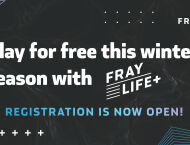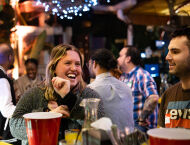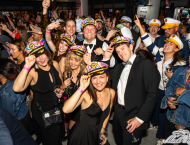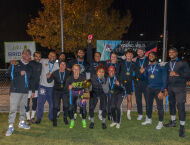Culture
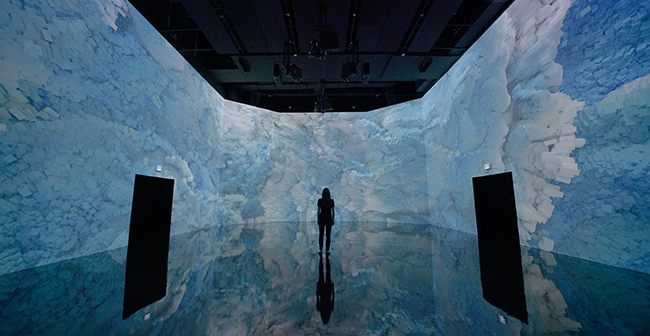 Photo: Refik Anadol, courtesy of ARTECHOUSE
Photo: Refik Anadol, courtesy of ARTECHOUSE
Exploration Of DC’s Powerful, Impactful Art
June 29, 2019 @ 12:00am
In today’s social climate, art is the epitome of pushing the conversation forward. With many adversities dividing our communities, the use of mediums like design, sculpture and film allow the world to see a perspective through another person’s lens. Our nation’s capital is the epicenter of politics, diversity and community, so it’s no surprise that the District’s art reflects the same. New exhibits and installations are being created to highlight civil rights, social justice and political reform addressing the huge gap in peace and prosperity. We handpicked some of the summer exhibits and public works of art making a lasting impact in and around the city.
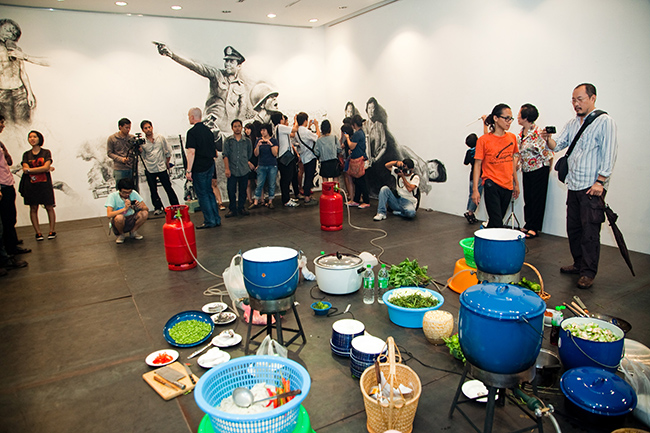
Photo: Tex Williams, courtesy of Hirshhorn
Rirkrit Tiravanija: (who’s afraid of red, yellow, and green)
The Hirshhorn has always been known for its focus on contemporary art, inspiring people to step back and take the time to think over what is being presented. The same case follows here for “Rirkrit Tiravanija: (who’s afraid of red, yellow, and green).” Through July 24, the exhibit from Thai artist Rirkrit Tiravanija is encouraging visitors to consider many sensory feelings – especially because curry from Beau Thai in Mount Pleasant is served as you watch the mural appear in front of you. We spoke with Dr. Mark Beasley, the Hirshhorn’s curator of media and performance art, about bringing this interactive exhibit to the museum and working with Tiravanija.
On Tap: What attracted you to Tiravanija’s work and why was it important for it to be showcased?
Mark Beasley: [He’s] somewhat of a figurehead for the Thai artists that appeared in the 90s. He creates a social engagement with the audience. He facilitates a social space within galleries. The work is about activism and protest culture. It connected very well with the history of the city but also had two key threads: the serving of food as an art piece.
OT: What was the process like to bring this show to life?
MB: The process in general was two-fold: food and drawings. With the food, we looked to find a collaborator in the city: restaurant Beau Thai. They worked with Rirkrit to come up with a recipe that he was happy with and seemed authentic to him. The 18 mural artists working for and with Rirkrit are drawing these images taken from the mainstream press of protests over the last 40 years both in Bangkok and Washington. At any time, there are [up to] three artists in this space drawing directly onto the walls.
OT: How does serving curry play into the overall sensory experience?
MB: It is another flavor and ingredient in the room. It sets up a space of sociability. It is an immediate hook. You go and get food and sit, and then you are in a room of drawings so the discussion stems from there. In terms of sensory [experience], [it’s] very much this other vocabulary that most of us are not used to thinking of. We are not used to thinking through those textures or what that means to the space or a room. It brings part of Thailand into this space, into this museum.
“Rirkrit Tiravanija: (who’s afraid of red, yellow, and green)” runs through July 24. Go to www.hirshhorn.si.edu for details.
Hirshhorn Museum and Sculpture Garden: Independence Avenue and 7th Street in NW, DC; www.hirshhorn.si.edu
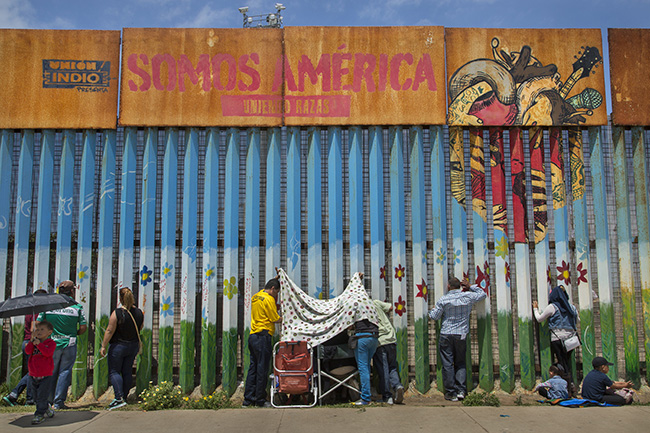
Photo: Griselda San Martin
“The Warm of Other Suns: Stories of Global Displacement”
“The Warm of Other Suns: Stories of Global Displacement” at the Phillips Collection through September 22, presents a group of global artists whose work asks urgent questions about the experiences and conceptions of migration and the refugee crisis that many countries are living through. Through the lens of installations, videos and paintings, viewers are shown real and artistically created geographies creating tales of migration, while adding historical elements on top of them. Global artists Richard Wright, Isabel Wilkerson and Jacob Lawrence are featured in this exhibit, conveying the powerful message of migration that affects our world today. We chatted with curator Massimiliano Gioni, who gave us his interpretation of this impactful exhibit.
On Tap: How did you get started in this line of business? Why did you want to become a curator of art?
Massimiliano Gioni: I was a teenager when I started getting interested in contemporary art and gradually, I wanted to spend my life being surrounded by it. Around 1990, when I entered the world of art professionally, I didn’t think curation was a profession. For a long time, I thought I would’ve had another life that eventually would’ve led me to art. I struggled for a while within the art community, but fortunately and beyond my wildest imagination, everything fell into place.
OT: What makes a piece of art something worth showcasing?
MG: It’s a combination of numerous things. On one hand, it’s the effect that it feels just right, that anything you do to it won’t compromise it, that nothing could be added to or subtracted from it, [that it’s] personal and individual to the point of being unconventional. On the other hand, it’s endlessly incomparable because every time you return to it, you learn something new and in return, you learn something new about yourself.
OT: Is there a specific impression you would like viewers to have of “The Warmth of Other Suns”?
MG: There are three central questions in the show that they address. One is the representation of pain and misery. The second is the question of documentary and the repercussions – the way in which we can claim to tell the truth or represent a truth. And the third is the relationship between the individuals and the masses – between self and the multitudes of self.
OT: What inspired you to get involved with this exhibit? How has your background influenced your choice in curation?
MG: This is my second show. I did a show in Italy two years ago called “The Restless Arms.” In the summer in Italy, we are used to seeing thousands of civilians die crossing the Mediterranean and in a sense, I felt that we had some kind of responsibility to engage in this issue through this exhibition. One of the reasons I went [with this exhibition] is to basically say, “No more.” Also, because of the diversity within this show, it presents a much more vibrant and open conversation [about] the multicultural idea of society in contemporary art.
OT: With the topic of migration at the center of this exhibit, what kind of realities have you faced curating these works of arts?
MG: I think the interesting aspect is that we are looking at certain realities as they are constructed through images – how contemporary art is addressing the concept of truthfulness and accuracy, and how images can contract reality. What I hope is that people will go through this exhibition and understand that the people we call migrants are not so different from ourselves and our own families.
Tickets are $12; exhibit runs through September 22. Learn more about “The Warmth of Other Suns” at www.phillipscollection.org.
The Phillips Collection: 1600 21st St. NW, DC; www.phillipscollection.org
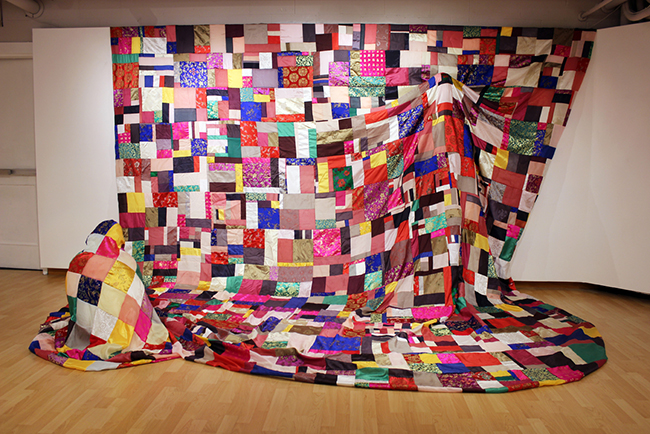
Photo: courtesy of Torpedo Factory
Julia Kwon’s “More Than A Body”
“More Than A Body,” at the Torpedo Factory through August 4, represents Asian femininity within modern society. Enduring objectifications as a Korean woman, local artist Julia Kwon uses the art of textiles to address and open the conversation of cultural propriety within the United States. Her use of authentic Korean materials pays homage to her culture and allows her to focus on influences such as globalism and totalitarianism. Chosen from nearly 130 artists, Kwon’s exhibit highlights the fusion of authenticity and appropriations. Panelists Sandy Guttman, Michael Matason and Terrence Nicholson played a huge role in putting this powerful exhibit together. Before visiting, we caught up with Kwon to learn more about her experience creating this exhibit.
On Tap: How has your background influenced your work?
Julia Kwon: I decided to study art seriously and make sense of the world through creating art. My work is directly influenced by the society that I live in. I discuss my experiences of being seen differently in the U.S. based on my gender and ethnicity. I also reference current sociopolitical events through the inclusion of contemporary logos to challenge the expectation of cultural purity.
OT: What inspires you as an artist?
JK: Artmaking is the struggle to better understand myself, the world I live in, and what it means to live fully and justly. I am continuing to challenge myself to think of more effective ways to expose the problematic constructions of Asian femininity within the U.S. context.
OT: What objectification have you faced as a Korean woman?
JK: I have experienced discrimination based on the way I look, which includes larger, systemic inequalities as well as microaggressions – whether that was being subjected to others gazes or racist and sexist comments. I’ve also felt the pressure to prove or perform cultural purity and authenticity, even from well-meaning allies.
OT: Why did you choose textiles to convey your message?
JK: I became involved with textile art quite organically as it allowed me to effectively talk about my experiences of being seen differently based on my gender and ethnicity. I am drawing inspiration from Korean textiles because it is specifically Korean, yet the abstract designs allow the space for complexity, nuance and ambiguity. I use traditional Korean silk as well as fabrics that were created from around the world and found here in the U.S. to question the idea of authenticity and shift the focus to the influences of globalism, transnationalism and cultural hybridity.
OT: What would you say to other women about handling these kinds of adversities?
JK: I aim to present my specific point of view and experiences as a Korean-American woman, as well as to spark conversations and position us to experience a more sweeping glance at issues regarding gender, ethnicity and other categories. I want women and other people who have had similar experiences to know they are not alone in the struggle to be a distinct and multifaceted human being.
OT: If there is one thing that you would like your audience to take away from your work, what would it be and why?
JK: Although they may be initially drawn to the work for its vivid colors and lush materiality, the content of the work seems to be what ultimately resonates with them. I have had viewers interpret the positions of the figures very differently and I welcome diverse readings of my work. The fabrics are not only covering, blocking and suffocating, but also protecting, hiding and mystifying the body. The figures are both burdened by the expectation of authenticity yet free to be comfortably themselves behind the constructed façade.
“More Than A Body” runs through August 4. Learn more at www.torpedofactory.org and about Kwon at www.juliakwon.com.
Torpedo Factory Art Center: 105 N. Union St. Alexandria, VA; www.torepedofactory.org
“Art in Action”
The Library of Congress hosts many historic and awe-inspiring exhibits of art, including “Art in Action.” This particular exhibit feels quite crucial to recognizing events throughout history in a more fun and engaging way; presented in an easily digestible format, it brings together those taking in the art and the world that they live in. Some notable artists featured include Shepard Fairey, Pablo Picasso and Helen Zughaib. Runs through August 17. Library of Congress: 101 Independence Ave. SE, DC; www.loc.gov
“Chicago Titan”
One might not think of finding a large Romanesque sculpture outside of the Hirshhorn Sculpture Garden, but if you venture a bit from the city, you’ll find one nestled in the hustle and bustle of Rosslyn. “Chicago Titan” is a large sculpture created by Ray Kaskey, known for his large-scale civic art pieces that follow Greek and Renaissance themes. Look for it the next time you find yourself in Arlington. 1530 Wilson Blvd. Arlington, VA; www.rosslynva.org
DC Mural Walking Tour
DC is often recognized as a place full of monuments and history, but it has become so much more. The DC Mural Walking Tour has become a staple, taking locals a step further into the variety of public murals in the surrounding wards and neighborhoods of the city. This tour makes the art both accessible and informative to the public and has much to offer expressively. Check the official website for more information on where to get tickets and what areas these tours start in. www.dcmurals.org
“I Am…Contemporary Women Artists of Africa”
The National Museum of African Art is putting a twist on their upcoming exhibit, featuring 28 female artists. While addressing topics like racism, identity and politics, it also shines a light on women empowerment and the African experience. This diverse approach to contemporary art opens versatile perspectives within the creative community. Runs through March 2020. National Museum of African Art: 950 Independence Ave. SW, DC; https://africa.si.edu
“Infinite Space”
We live with a sense that there will one day be an end, but we rarely stop to think of the infinite possibilities. “Infinite Space” reflects the concept wherein visitors can open their minds to endless ideas and opportunities, as well as the transformative ways of man and machine. The exhibit invites you to look through the lens of a machine and how it perceives the world as a human. If you’re looking for an experience that will both open and expand your mind, this is for you. Tickets are $16. Runs through September 2. ARTECHOUSE: 1238 Maryland Ave. SW, DC; www.dc.artechouse.com
“Lightweave”
One may not think of an underpass as having the ability to showcase a magnificent work of art, but “Lightweave” is a fun, interactive experience for everyone. This piece also brings the city to life because it takes all the varieties of sounds in NoMa and turns them into beautiful LED lights. “Lightweave” fully showcases the interactivity and accessibility of the city in order to bring a standard underpass to life. L Street Underpass: 2nd Street in NE, DC; www.futureforms.us/lightweave
“ReCOVERing the Classics”
Workhouse Art Center’s interactive exhibit showcasing redesigned book covers will have you reminiscing about the Scholastic Book Fairs of your childhood. This exhibit captures the importance of what is sometimes lost in modern literature. Runs through August 4. Workhouse Art Center: 9518 Workhouse Way, Lorton, VA; www.workhousearts.org
“Rise Up: Stonewall and the LGTBQ Rights Movement”
Honoring the 50th anniversary of the Stonewall riots, the Newseum pays tribute to the LGBTQ civil rights movement by highlighting the trials and tribulations that sparked the revelation of LGBTQ First Amendment freedoms. With the use of artifacts, images and historic publications, “Rise Up” offers a glimpse inside this fight for equality. Runs through December 31. Newseum: 555 Pennsylvania Ave. NW, DC; www.newseum.org
“Solaris Shelter for The Next Cold War”
Critically acclaimed artist Mark Kelner uses his artistic creation to make a fun, interactive experience at Culture House DC (formerly Blind Whino). His pop-up exhibit addresses the tension of war propaganda in modern America, and his funny sneer at modern advertisements creates a unique approach to using art as a way to address sometimes uncomfortable issues. Runs through July 7. Culture House DC: 700 Delaware Ave. SW, DC; www.culturehousedc.org



